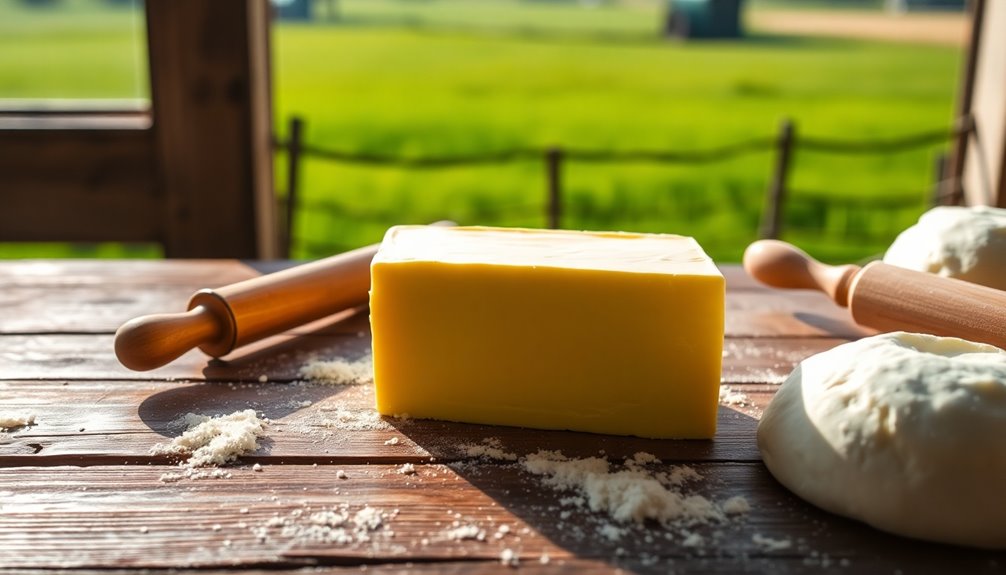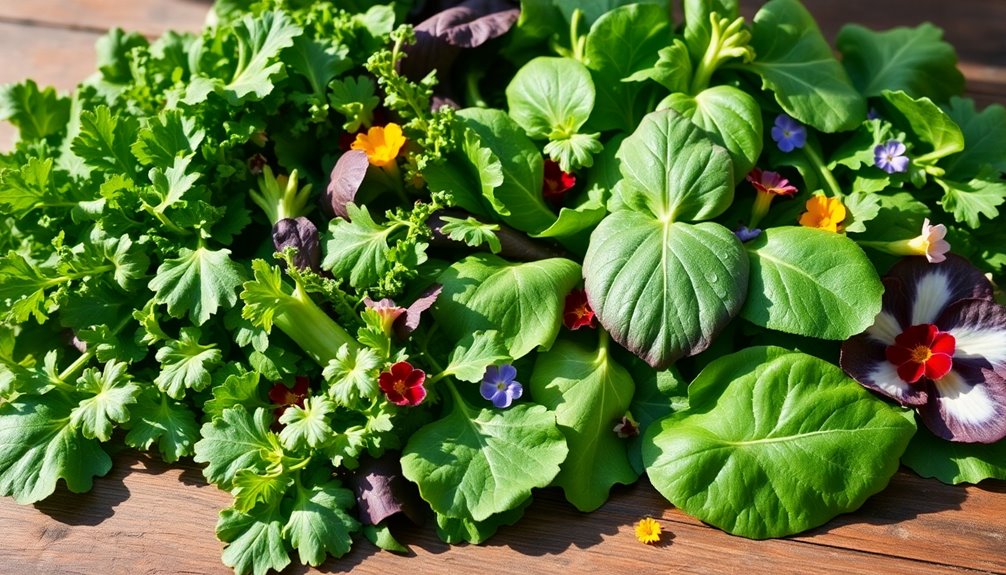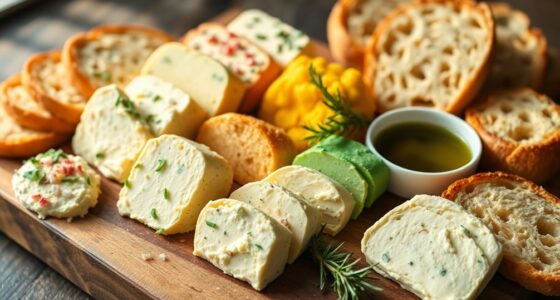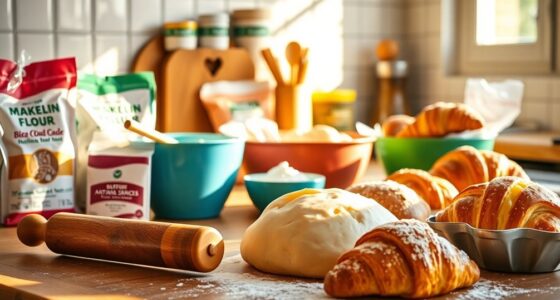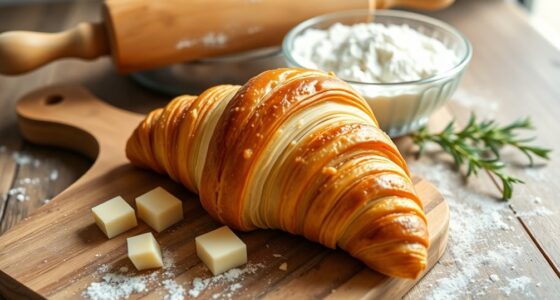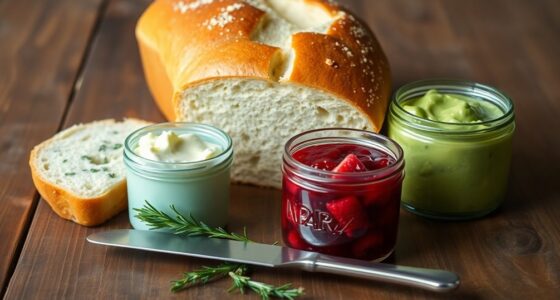Butter's journey from farm to table starts with quality milk, sourced from grass-fed cows in areas like The Cotswolds. This milk undergoes meticulous churning to create varieties such as unsalted and grass-fed butter, enhancing your baked goods' flavor and texture. Butter adds moisture, richness, and a golden crust, all essential for success in baking. By using local ingredients, you support sustainability and elevate your culinary experience. Discover how different types of butter can further enhance your baking.
Key Takeaways
- The journey of butter begins with sourcing high-quality milk from grass-fed cows, enhancing flavor and texture for baking.
- Rigorous quality checks ensure only the best local cream from The Cotswolds is selected for butter-making, supporting regional agriculture.
- The churning process involves mixing cream and separating butterfat to create a velvety texture essential for baked goods.
- Butter enriches baked items with moisture, tenderness, and flavor, contributing to a golden-brown crust through the Maillard reaction.
- Nutritional benefits include fat-soluble vitamins and healthy fats, making butter a valuable addition when used in moderation in baking.
The Importance of Quality Milk in Butter Production
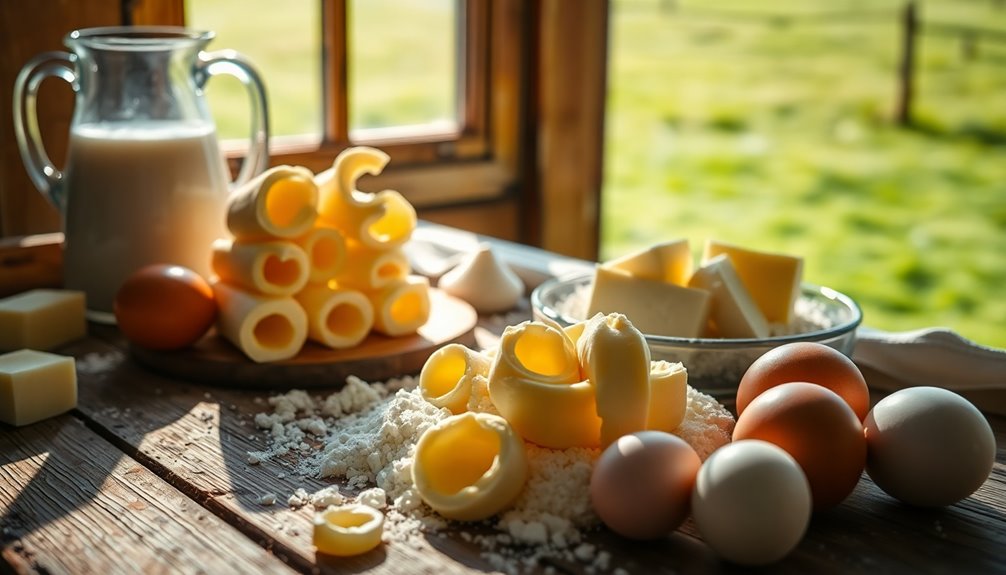
When it comes to crafting exceptional butter, the foundation lies in the quality of the milk used.
You'll find that milk from cows grazing on nutrient-rich grasses, like those in The Cotswolds, creates cream with an unparalleled richness and flavor. High-quality milk isn't just a nice-to-have; it greatly influences the taste, texture, and overall quality of your butter.
That's why rigorous quality checks and analysis are performed on milk samples, ensuring only the best milk is selected for butter-making.
The meticulous care given to cows and their diets at the farm directly impacts the milk's richness, which is essential for making outstanding butter. Additionally, the use of anti-inflammatory properties in natural ingredients, like turmeric, can enhance the health benefits of baked goods made with high-quality butter.
The Process of Churning Cream Into Butter
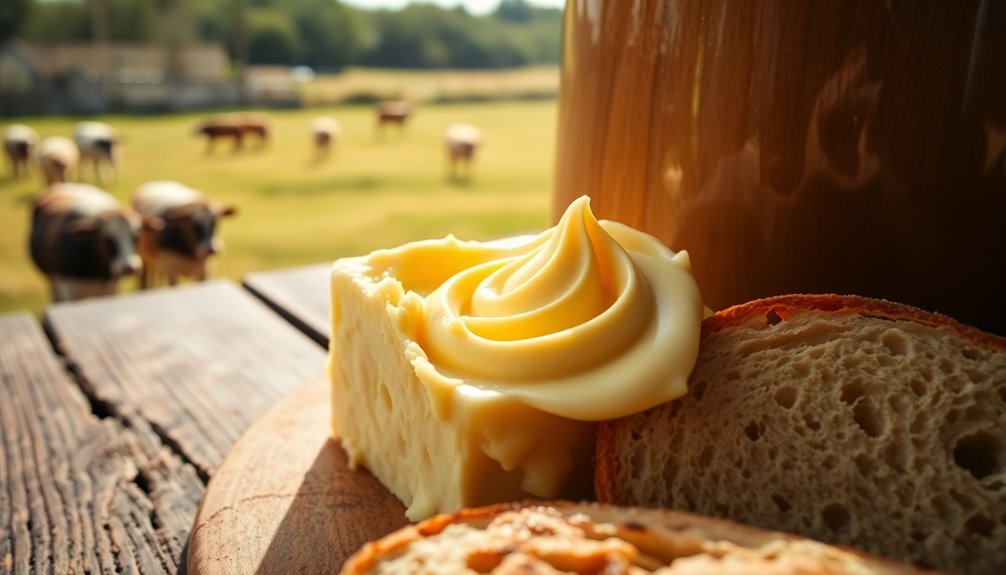
To transform cream into butter, you start by mixing heavy cream at medium speed for about 2-3 minutes, until you notice small curdles forming.
Next, increase the speed to medium for another 2-3 minutes to enlarge those curdles.
Finally, crank it up to high speed for 5-7 minutes, and watch as the butterfat separates from the buttermilk.
Once that's done, drain off the buttermilk and rinse the butter under cold water until it runs clear, ensuring you remove all residual buttermilk to prevent spoilage.
If you like, add a pinch of salt for flavor after patting the butter dry with a paper towel.
In about 20 minutes, you've got a cup of fresh butter! This process can yield different types of butter, including salted butter or unsalted, depending on your preference.
How Butter Enhances Baked Goods

Butter plays an essential role in baking, as it not only adds richness and moisture but also enhances the overall flavor of your creations.
When you use butter, you're ensuring a tender crumb in cakes and pastries, while its fat content helps baked goods rise, achieving that light, airy texture in cookies and muffins.
Creaming butter with sugar incorporates air, resulting in fluffier results. The Maillard reaction, driven by the natural sugars in butter, gives your bread and pastries a golden-brown crust and deeper flavor.
Don't forget salted butter; it balances sweetness and elevates the taste experience. Additionally, the creamy texture of butter is influenced by the emulsification process during churning, making it a crucial ingredient in many baking recipes.
Sourcing Local Ingredients for Superior Flavor
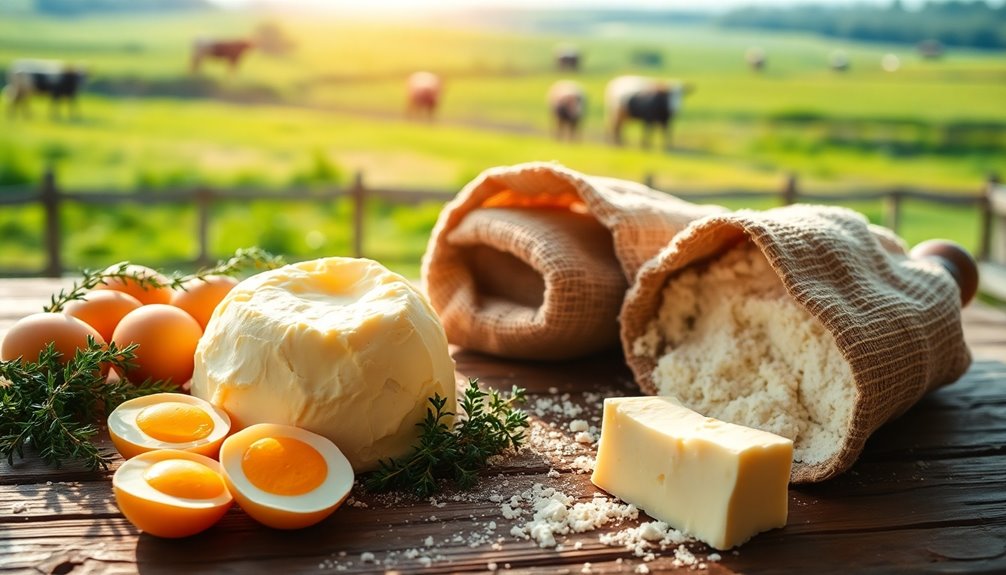
Using high-quality butter can greatly elevate your baked goods, but sourcing local ingredients takes that flavor to the next level.
When you choose local cream from The Cotswolds, you're ensuring that your butter retains a rich flavor profile that enhances every bite. Local farming practices prioritize nutrient-rich grasses for grazing cows, which contributes to the unique taste of the butter.
By utilizing local dairies for the freshest milk, you not only support regional agriculture but also guarantee that your butter is crafted from superior cream. This focus on sustainability and quality profoundly impacts the final flavor of your baked goods.
The meticulous selection of local ingredients, combined with expert craftsmanship, results in a distinctive Cotswold flavor that truly elevates your baking.
The Art and Science of Butter Crafting
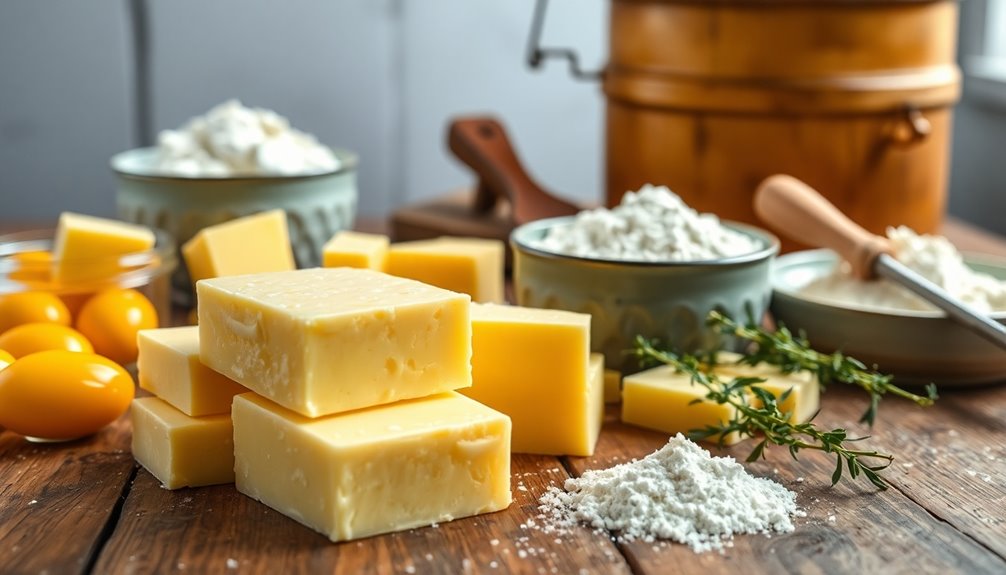
While many appreciate the rich flavor of butter, few realize the intricate process behind its creation. Butter is made from fresh milk that undergoes pasteurization, churning, and separation. Expert artisans meticulously balance flavor profiles and texture during this crafting process, taking 10-15 minutes of churning to achieve velvety perfection. With careful quality checks throughout, they verify that every batch meets high standards before reaching you. Additionally, the use of continuous butter churns allows for automated production, ensuring consistency in quality and taste.
| Stage | Description | Importance |
|---|---|---|
| Pasteurization | Heating milk to kill bacteria | Ensures safety |
| Churning | Mixing cream at varying speeds | Creates desired texture |
| Separation | Splitting cream from buttermilk | Essential for butter formation |
| Flavoring | Adding ingredients like Welsh salt | Enhances overall taste |
| Quality Check | Rigorous inspections of the final product | Guarantees consistency |
Nutritional Considerations in Butter Usage
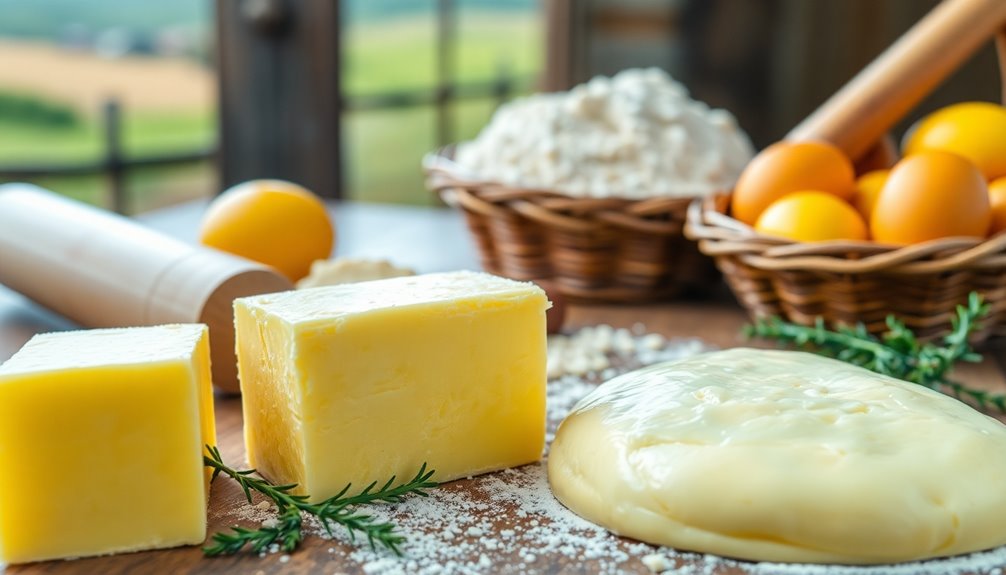
The rich flavor and creamy texture of butter not only elevate baked goods but also offer several nutritional benefits.
It's packed with fat-soluble vitamins A, D, E, and K, essential for your overall health. Plus, the butyrate in butter has been linked to anti-inflammatory benefits and improved gut health.
If you choose grass-fed butter, you'll enjoy higher levels of omega-3 fatty acids and conjugated linoleic acid (CLA), enhancing its nutritional profile.
With its low lactose content, butter's a great option for those who are lactose intolerant.
When used in moderation, butter can fit into a balanced diet, adding flavor and helping your body absorb nutrients from other foods, especially when cooking and baking. Additionally, the use of grass-fed butter has gained popularity due to its superior health benefits.
The Role of Butter in Traditional Baking
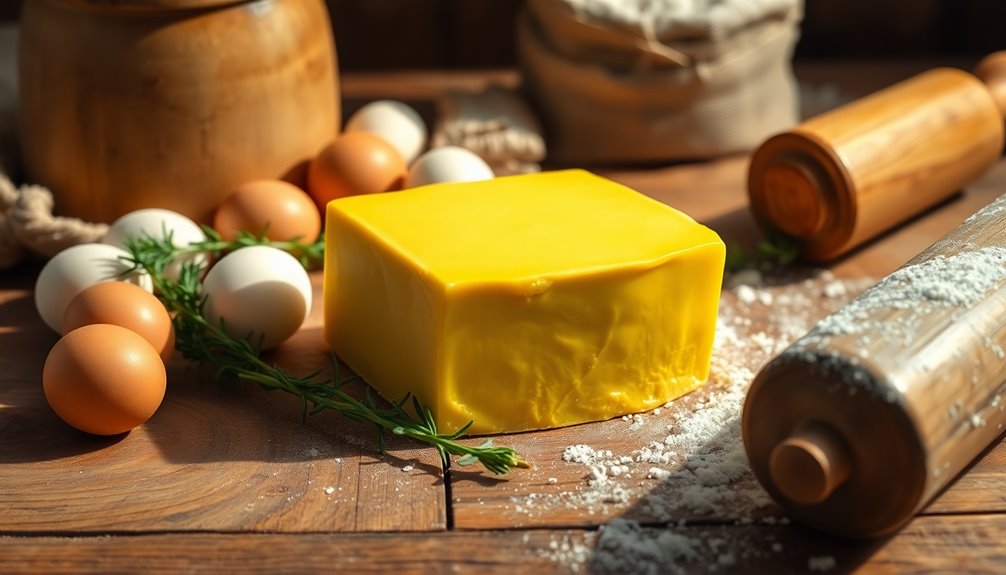
Butter's essential in traditional baking, as it not only enhances flavor but also contributes to the texture of your favorite treats.
The unique richness of high-quality butter, especially from regions like The Cotswolds, elevates the taste of cakes, cookies, and pastries.
When you bake, butter's emulsifying properties help blend ingredients smoothly, resulting in a consistent batter or dough that's critical for that perfect texture.
The fat content in butter plays an important role in leavening, trapping air during mixing for a light, airy finish.
Expert bakers rely on butter as a key ingredient, skillfully balancing its flavor and nutritional aspects to cater to health-conscious consumers while staying true to traditional baking standards.
Additionally, using unsalted butter allows bakers to control the salt content in their recipes more precisely.
Storage and Shelf Life of Butter
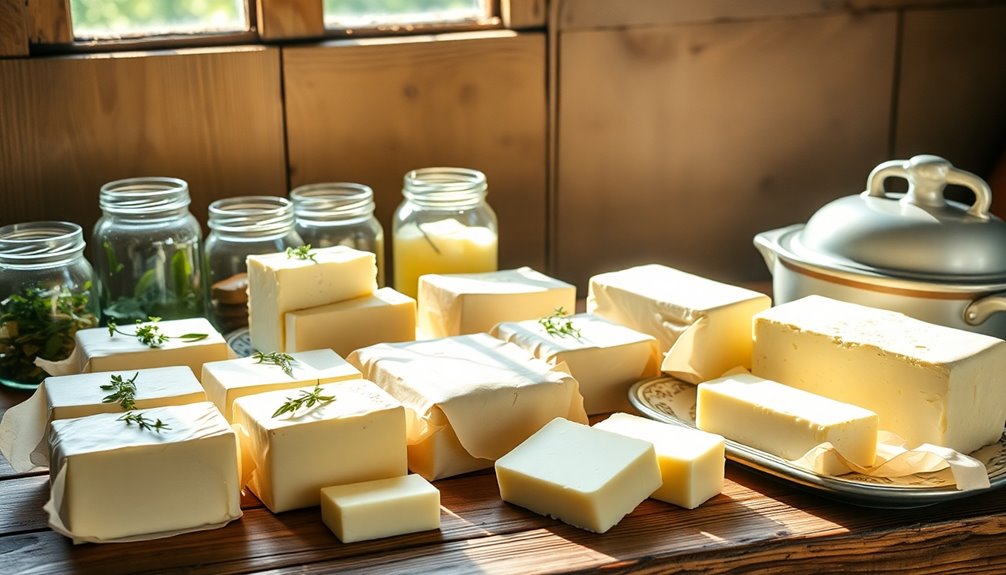
When it comes to keeping your butter fresh, proper storage is key to maximizing its shelf life. Raw butter can last up to 60 days in the refrigerator, and if you store it correctly, it can sit at room temperature for 7-10 days.
If you want to extend the shelf life of butter even further, consider freezing it—unsalted butter keeps for about 6 months, while salted butter can last up to a year. Understanding the differences between salted and unsalted butter can also aid in achieving desired flavor profiles in various dishes.
To maintain freshness and flavor, always store your butter in an airtight container.
Exploring Different Types of Butter
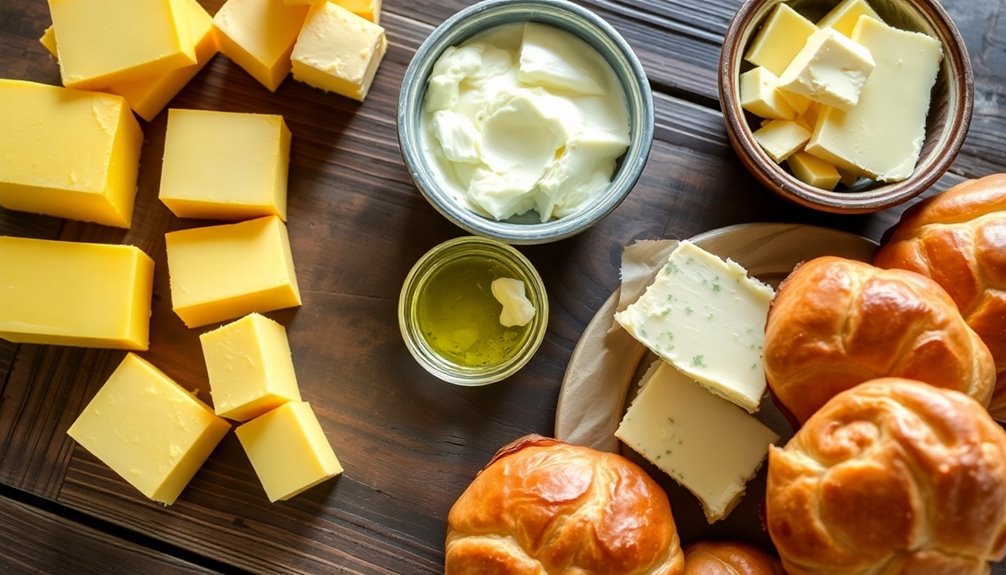
While exploring the world of butter, you'll discover that not all types are created equal.
Pasteurized butter is your go-to for safety, as it's made from milk heated to eliminate harmful bacteria. On the other hand, raw butter, crafted from unpasteurized milk, offers a richer flavor and retains more nutrients, especially when made from grass-fed milk.
If you're baking, unsalted butter is ideal since it gives you control over salt levels in your recipes.
Don't overlook specialty butters like cultured or compound varieties, as they enhance taste with added flavors.
Finally, remember the butterfat content—higher fat means your baked goods will be richer and creamier, making a significant difference in texture and moisture.
Elevating Culinary Experiences With Butter
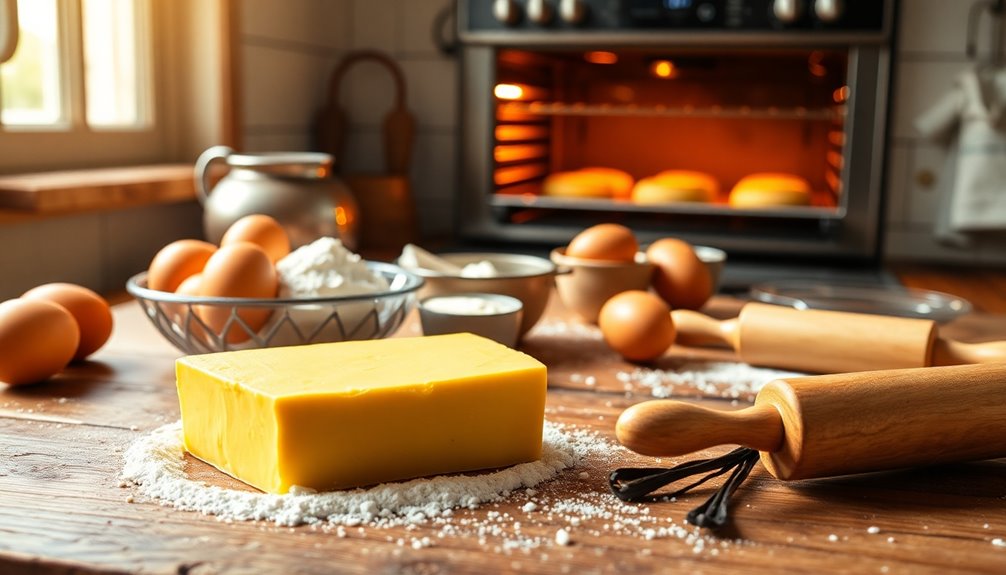
Quality butter considerably elevates your baking experience. When you use high-quality butter made from cows grazing on nutrient-rich grasses, you enhance the flavor and texture of your pastries, cookies, and cakes.
The meticulous churning process transforms cream into velvety butter, giving your baked goods a unique mouthfeel that truly delights. Adding Welsh salt to your butter not only boosts its flavor profile but also balances the overall taste of your creations.
Its versatility allows you to use butter as a spread, baking ingredient, or flavor enhancer, making it an essential kitchen staple. With convenient 150g or 250g portions, you can easily measure and incorporate the right amount of butter for ideal results, taking your culinary experiences to new heights. Additionally, the rising popularity of plant-based spreads indicates a shift in consumer preferences towards healthier alternatives.
Frequently Asked Questions
How Does Climate Affect the Quality of Milk Used for Butter?
Climate considerably impacts the quality of milk used for butter.
When temperatures rise, cows might produce less milk, and the milk's fat content can vary, affecting butter's texture and flavor.
Humidity can influence feed quality, which also plays a role in milk production.
You might notice that the best butter often comes from cows raised in stable, moderate climates, where their health and diet remain consistent, leading to richer, creamier milk.
What Are the Different Grades of Butter Available in the Market?
When you're shopping for butter, you'll encounter several grades. The most common are Grade AA, A, and B.
Grade AA is the highest quality, known for its rich flavor and smooth texture, perfect for baking.
Grade A is slightly less rich but still great for everyday use.
Grade B, while lower in quality, works well for cooking where butter's flavor isn't as prominent.
Knowing these grades helps you choose the best butter for your needs.
Can Butter Be Substituted in Baking Recipes?
You can absolutely substitute butter in baking recipes, and it might even feel like you're on a culinary adventure!
Margarine, coconut oil, or even applesauce can step in, transforming your treats into something new and exciting.
Just remember, each substitute brings its own flair, so your cookies might dance with a different flavor or texture.
Embrace the change; you'll discover delightful surprises waiting for you in the oven!
How Do I Identify High-Quality Butter at the Store?
To identify high-quality butter at the store, check the packaging for a high-fat content, ideally around 80% or more.
Look for butter labeled as "European-style" for a richer flavor.
Inspect the color; it should be a pale yellow, indicating it's made from fresh cream.
Read the ingredient list—real butter should have minimal ingredients, primarily cream and salt.
Finally, choose brands that emphasize grass-fed cows for even better quality.
What Are Some Common Allergens Associated With Butter?
Just as Achilles had his heel, butter has its allergens. While it's generally safe, some people may react to dairy, which contains lactose and proteins like casein.
If you're lactose intolerant or allergic to dairy, you'll want to steer clear. Additionally, butter substitutes might introduce other allergens, like nuts or soy.
Always read labels carefully to protect yourself, and don't hesitate to consult a healthcare provider for personalized advice.
Conclusion
In the end, the journey of butter from farm to table is a delightful coincidence of nature and craft. When you grab a stick of quality butter, you're not just adding flavor; you're connecting with local farmers and centuries of baking tradition. Whether it's a flaky pastry or a rich cake, that golden ingredient transforms your kitchen creations into something truly special. So, the next time you bake, remember: butter isn't just an ingredient; it's a flavorful story waiting to unfold!
